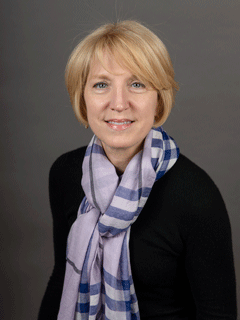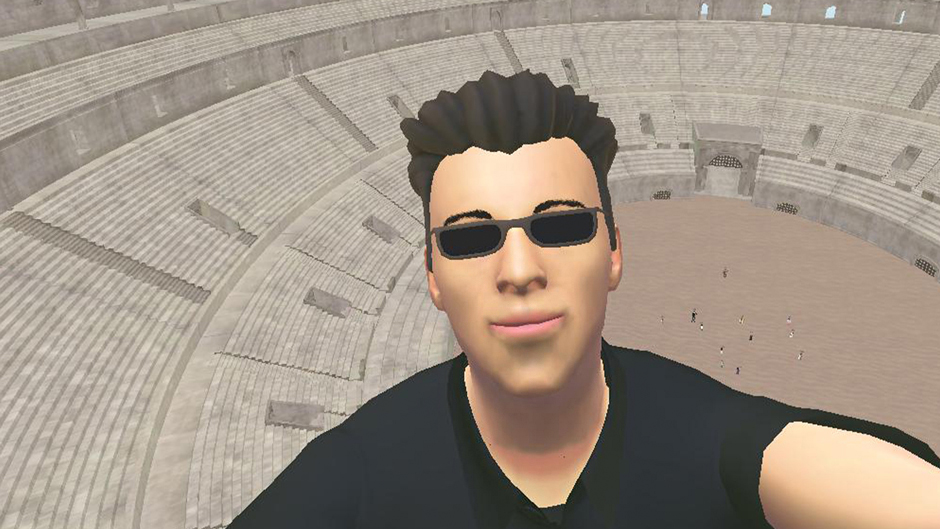From the first time Karen Mathews donned a virtual reality headset, she saw infinite possibilities.
Mathews, a professor of art history in the University of Miami College of Arts and Sciences, quickly recognized the immersive capability of the technology. For the last seven years, she has been working to integrate different virtual and augmented reality experiences into her art history classes.
This fall, Mathews was able to do what has only been a dream—she took students on a journey to art and architectural wonders across the world through her first class held in virtual reality (VR).

“In the past 30 years of teaching, I’ve shown a sequence of images that students have to put together on their own, but this class allowed me to be free of that because they were able to visit these places themselves,” said Mathews.
The students visited Stonehenge in England, the Hagia Sophia mosque in Turkey, the Acropolis in Greece, and several famous cathedrals in Spain and France. All from the comfort of their own homes—with headsets—and with Mathews, an architectural historian, as their tour guide.
“We were able to fly over the pyramids of Giza, and this bird’s eye-view allows you to see the entire complex of buildings, as well as the Sphinx,” Mathews added. “They could also walk around sculptures and get a sense of how these artifacts look from every single angle. Students were also able to manipulate some 3D models of artifacts, spin them around, and hand them to each other, so this technology gives us an opportunity for an incredible amount of interaction.”
To make the class possible, Joao Ribeiro, an extended reality architect at the Frost Institute for Data Science and Computing, designed the virtual gallery, collected dozens of 3-D models for each site experience or piece of art featured in the class and loaded them into a VR platform called Engage, where students attended class. The course will be offered again next fall, Mathews added.

“Through virtual worlds, you can remove restrictions and visit places that you often cannot even tour, so we are making these cultural artifacts and sites more accessible,” Ribeiro said.
But the entire class was not held in VR. While the trips to different monuments required students to don VR headsets, in between virtual classes, students met with Mathews for in-person classroom discussions about the different art pieces and sites. Hunter Holstein, a junior studying creative advertising, said she preferred the hybrid model to an all-VR course, since it was hard to take notes in virtual reality.
Despite a few technology challenges, Holstein loved the class—especially their visit to the Colosseum, the ancient sports amphitheater in Rome.
“The VR model was built at scale, so you could walk into the Colosseum, and you could teleport to different levels of the arena to get different views of it,” she said. “I was able to get up to the top and look down at the oval-shaped monument, while other students were running around the center at ground level.”
Aniya Johnson, a first-year student studying architecture, said seeing the pyramids of Giza in VR was an experience she will not forget. And being able to walk through many ancient structures helped her appreciate her major even more.
“We were in a chair flying around the pyramids,” she said. “The perspective was very interesting, but I also liked seeing the Roman Baths.”
While some of the models or experiences were better quality than others, students said that the experience of visiting these sites with Mathews was ideal.
“Professor Mathews had a lot of experience with these places, and hearing her talk about them was like getting our own personal tour because she was very knowledgeable about the art and history of these pieces and monuments, which made it more interesting,” Holstein said.
Victoria Locay, a junior studying classics, anthropology, and Cuban studies, loved visiting the Pantheon, a Roman temple, through the class, and comparing its antique structure—recreated in VR—with its current structure through a Google Maps experience. Locay also liked exploring the Great Mosque of Córdoba, which was once a cathedral, then a mosque, and today serves as both in Spain.
“When you’re able to see art or structures reproduced in 3D, you really get a feel of how these ancient societies looked, and functioned,” she said. “It’s like the difference between going on vacation or reading a travel brochure. We can’t fly to these monuments, but in some cases, this is the closest we’ll get to visiting them or seeing them as they were.”

